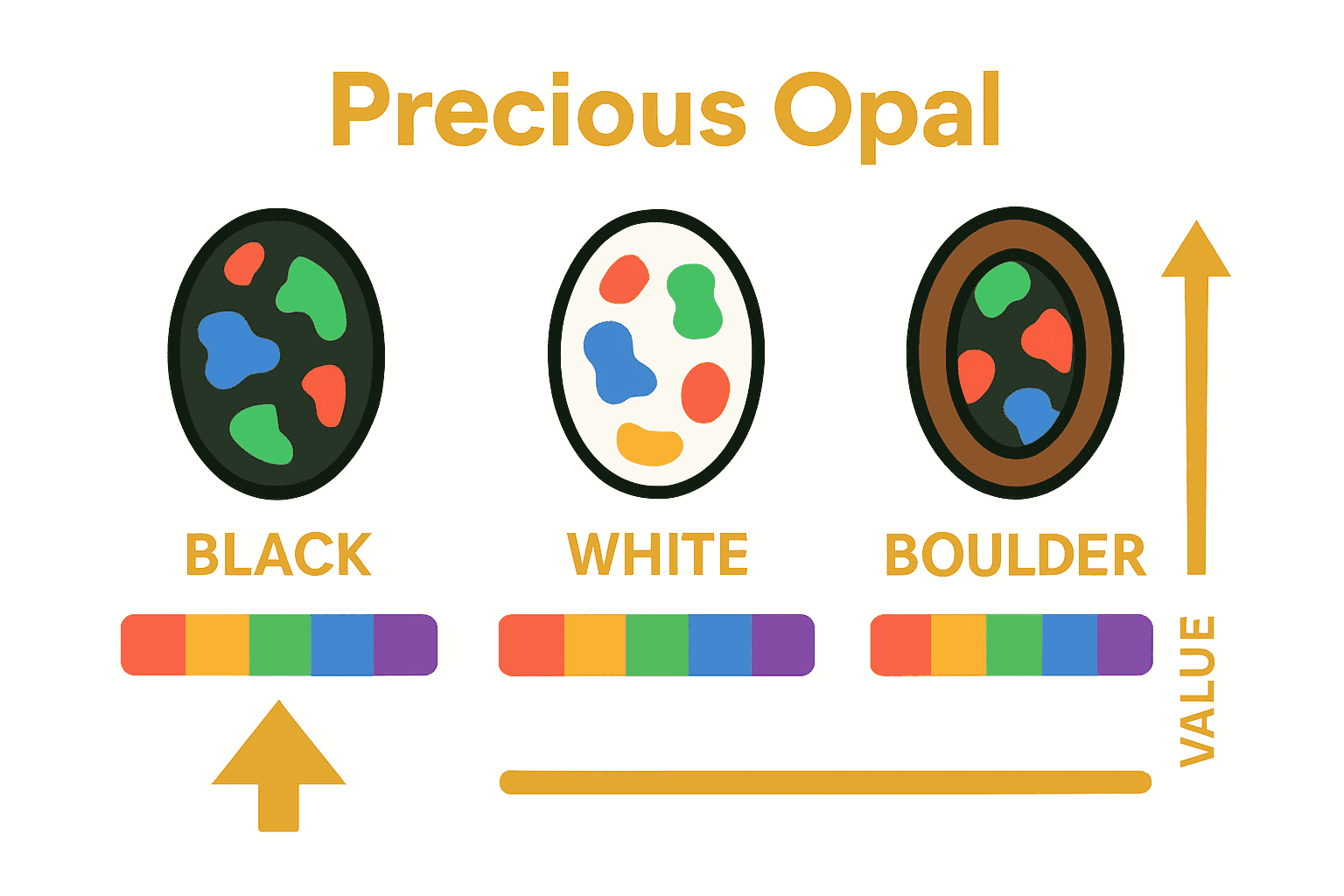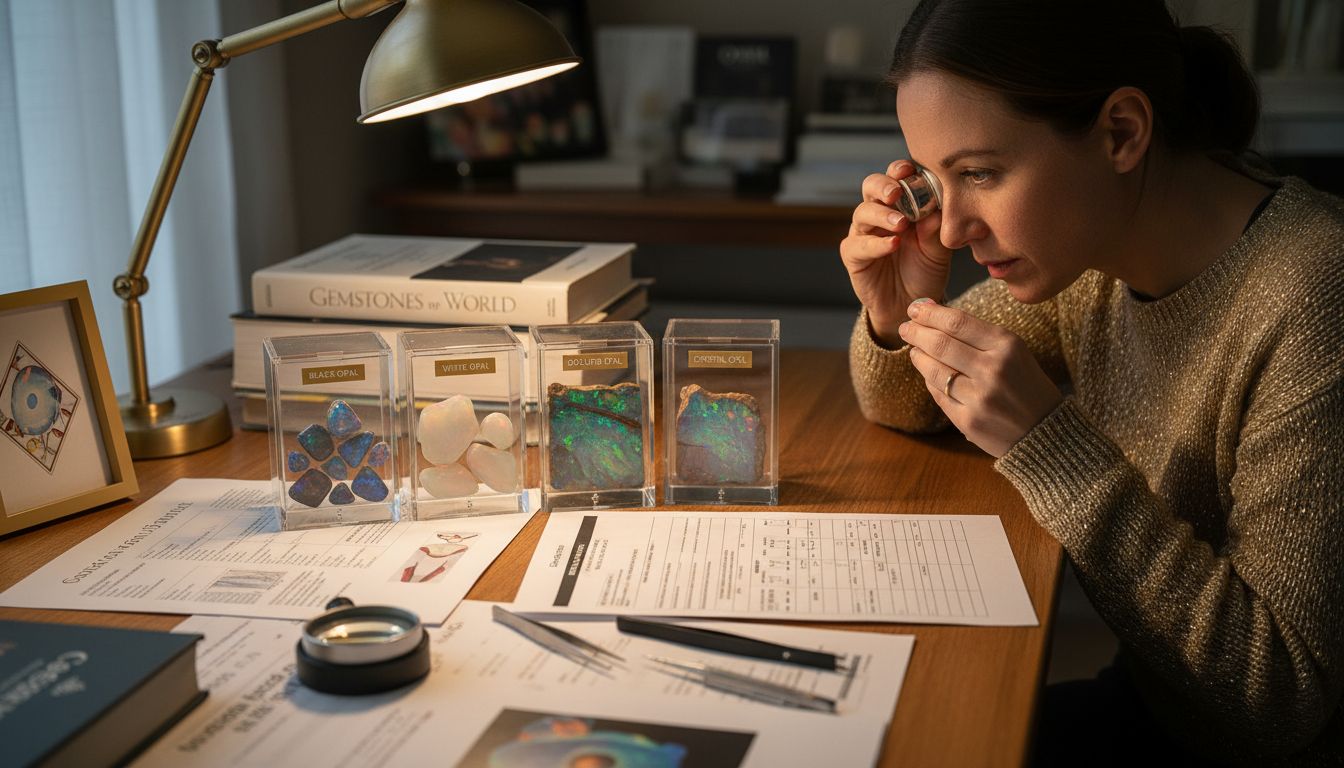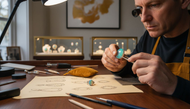What Is Precious Opal? Complete Guide to Types, Value, Uses
Posted by AOD on 10th Nov 2025
What Is Precious Opal? Complete Guide to Types, Value, Uses

Over 95 percent of the world’s precious opal supply comes from Australia, making this captivating gemstone a global rarity. The dazzling dance of color known as play-of-color sets precious opals apart from every other gem, enchanting collectors and jewelry lovers alike. Understanding what makes precious opal so unique helps reveal the science, origins, and true value behind these natural wonders, as well as why they deserve extra care and admiration.
Table of Contents
- Precious Opal Defined: Core Concepts And Origins
- Types Of Precious Opal Found Worldwide
- How Play-Of-Color And Body Tone Work
- Factors That Determine Opal Value And Rarity
- Common Misconceptions And Care Tips For Opal
- Precious Opal In Fine Jewelry And Collecting
Key Takeaways
| Point | Details |
|---|---|
| Precious Opal Characteristics | Precious opals are distinguished by their vibrant color shifts due to an orderly arrangement of silica spheres, which create the unique play-of-color effect. |
| Types of Precious Opals | Major varieties include black, white, boulder, and crystal opals, each offering unique visual characteristics influenced by body color and transparency. |
| Factors Influencing Value | The value of opals is primarily determined by brilliance, body tone, transparency, pattern, and the rarity of colors, with black opals being the most valuable. |
| Care Guidelines | Opals require special care due to their softness; avoid harsh chemicals and extreme conditions to maintain their beauty and prevent damage. |
Precious Opal Defined: Core Concepts and Origins
Precious opal is a mesmerizing gemstone renowned for its extraordinary optical phenomenon known as play-of-color. According to the Natural History Museum, this unique characteristic emerges from an intricate, orderly arrangement of silica spheres within the mineral’s internal structure. When light interacts with these precisely organized spheres, it diffracts and creates brilliant, shifting spectral colors that dance across the stone’s surface.
The origins of precious opal trace back millions of years, forming through complex geological processes involving silica-rich solutions depositing microscopic spheres in rock cavities and fissures. These spheres must be incredibly uniform in size and arrangement to produce the stunning play-of-color effect that distinguishes precious opals from common opals. The size and consistency of these silica spheres determine the specific colors and intensity of the light display.
Key distinguishing features of precious opal include:
- Vibrant, dynamic color shifts
- Consistent, orderly internal structure
- Rare geological formation conditions
- Unique optical light diffraction properties
While common opals appear uniform and lack visual excitement, precious opals transform light into a living, breathing canvas of color. Their rarity and complex formation make them not just gemstones, but geological miracles that capture the imagination of collectors and jewelry enthusiasts worldwide. Learn more about different opal types in our comprehensive guide.
Types of Precious Opal Found Worldwide
Precious opals are a diverse and fascinating group of gemstones with remarkable variations. According to the Colored Gemstone Association, the main commercial varieties include contra-luz opal, white opal, boulder opal, black opal, crystal opal, and moss opal. These classifications are determined by specific characteristics such as body color, transparency, and the distinctive play-of-color that makes each type unique.
The Gems Society provides a detailed rating system for opal body colors, ranging from N1 (blackest) to N9 (whitest). This nuanced approach helps gemologists and collectors understand the subtle variations in opal coloration. The most commonly used types in jewelry include:

- White (light) opal (N7-N9)
- Gray (dark) opal (N5-N6)
- Black opal (N1-N4)
Each type of precious opal offers its own visual enchantment.
 Black opals, with their dark body tone, showcase the most vibrant play-of-color, making them the most prized and valuable. White opals present a softer, more delicate display of colors, while crystal opals are celebrated for their transparent to semi-transparent nature that allows light to penetrate and enhance their internal color play. Explore the fascinating world of opal origins in our comprehensive guide.
Black opals, with their dark body tone, showcase the most vibrant play-of-color, making them the most prized and valuable. White opals present a softer, more delicate display of colors, while crystal opals are celebrated for their transparent to semi-transparent nature that allows light to penetrate and enhance their internal color play. Explore the fascinating world of opal origins in our comprehensive guide.
How Play-of-Color and Body Tone Work
Play-of-color is the magical optical phenomenon that makes precious opals truly extraordinary. According to the Gems Society, the gem’s body color plays a critical role in how this spectacular light display appears, with darker body tones often dramatically enhancing the vibrancy of spectral colors. This unique interaction between body tone and light diffraction creates a mesmerizing visual experience that sets precious opals apart from other gemstones.
The science behind play-of-color is rooted in the opal’s microscopic internal structure. Tiny silica spheres arranged in precise, orderly layers act like natural prisms, diffracting light and creating stunning color shifts. When light passes through these spheres, it splits into a rainbow of colors that seem to dance and shimmer across the stone’s surface. The size, uniformity, and arrangement of these spheres determine the intensity and pattern of the color display.
Key factors influencing play-of-color include:
- Sphere size and uniformity
- Angle of light interaction
- Underlying body tone
- Depth and arrangement of silica layers
The most prized opals demonstrate a full spectrum play-of-color, where multiple vibrant colors appear simultaneously.
Dark body tones provide the perfect backdrop for these color displays, creating maximum contrast and visual drama. Discover more about the intricate world of opal formation in our detailed guide.
Factors That Determine Opal Value and Rarity
The value of precious opals is a complex interplay of multiple critical characteristics. According to the Gems Society, several key factors determine an opal’s worth and rarity, with type being paramount. Black opals consistently command the highest prices, followed by boulder and white opals, reflecting the nuanced hierarchy of opal varieties.
The most significant value determinants include:
- Brilliance: The intensity and vibrancy of color play
- Body Tone: Darker tones typically increase value
- Transparency: Clarity and light penetration
- Pattern: Broad flashes and large color displays are most desirable
- Dominant Diffracted Colors: Rare color combinations boost value
- Color Bar Thickness: Wider, more consistent color bars are prized
- Overall Shape: Symmetry and cut quality matter
Rarity transforms an already exceptional gemstone into a true collector’s treasure. The most valuable opals demonstrate a perfect storm of characteristics: a dark body tone, intense play-of-color with multiple vibrant hues, large and consistent color patterns, and exceptional transparency. While some opals might excel in one or two areas, those rare specimens that combine multiple high-quality attributes become true investment-grade gemstones. Explore our comprehensive guide to understanding opal value in depth.
Common Misconceptions and Care Tips for Opal
Many jewelry enthusiasts misunderstand the delicate nature of precious opals. According to the International Gemstone Testing Laboratory, opals are soft gemstones that demand meticulous care and protection. Unlike harder gemstones, they are vulnerable to damage from environmental factors and require a gentle approach to maintenance and storage.
Key care guidelines for preserving your opal’s beauty include:
- Avoid direct sunlight and extreme temperatures
- Keep away from harsh chemicals
- Never use ultrasonic or steam cleaners
- Clean only with a soft, damp cloth
- Store separately from other jewelry
- Protect from sharp blows and physical pressure
Common misconceptions can lead to unintentional damage. Many people incorrectly believe opals are as durable as diamonds or can withstand rough handling. The Gems Society warns that prolonged exposure to water, sudden temperature changes, and mechanical stress can cause cracking or permanently damage the stone’s signature play-of-color. Treating your opal with respect means understanding its unique vulnerability and creating a protective environment. Discover more expert tips for preserving your opal jewelry.
Precious Opal in Fine Jewelry and Collecting
Precious opals have long captivated jewelry designers and collectors with their extraordinary visual appeal. According to Gemstone.org, opals are versatile gemstones used in various jewelry types, including earrings, rings, and pendants, with their unique play-of-color making them a favorite among creative designers seeking distinctive pieces.
The most coveted opal jewelry pieces showcase the stone’s natural brilliance through strategic design choices:
- Minimalist settings that maximize light interaction
- Complementary metal tones that enhance color play
- Custom cuts that highlight individual stone characteristics
- Intricate settings that protect the delicate gemstone
- Designs that capture movement and light dynamism
Australian opals dominate the global market, representing a stunning 95% of worldwide supply. The Gems Society notes that unique geological formations in Australia have produced exceptionally prized stones that are treasured by collectors and jewelry enthusiasts worldwide. Serious collectors often seek out rare, investment-grade opals with exceptional color play and provenance. Explore inspiring examples of exceptional opal jewelry designs.
Discover the True Beauty and Value of Precious Opal with Authentic Australian Gems
Understanding what makes precious opal unique can be overwhelming. The challenge lies in finding genuine opals that showcase the vibrant play-of-color, perfect body tone, and rarity described in this complete guide. Many enthusiasts struggle to source ethically mined, high-quality stones that truly capture the dazzling optical effects and rich heritage of opals from renowned Australian regions.
At Australian Opal Direct, we solve this problem by offering a curated collection of authentic Australian opals sourced directly from trusted miners in Lightning Ridge, Coober Pedy, and Queensland. Our jewelry pieces highlight the rare characteristics and craftsmanship that make each opal a living treasure. Whether you seek a striking black opal ring, a shimmering pendant, or a unique custom design, our selection brings you closer to owning the magic of these geological miracles.
Explore the full spectrum of precious opal types and enjoy benefits such as free shipping, complimentary insurance, and a 90-day warranty. Now is the moment to experience the radiant energy and storied history encapsulated in every piece.
Enhance your collection today with genuine, ethically sourced Australian opals that reflect the deep value and captivating beauty you learned about.

Take the next step to own a masterpiece by visiting Australian Opal Direct and discover our inspiring range of luxurious opal jewelry designed to impress and last a lifetime.
Frequently Asked Questions
What is precious opal and what makes it unique?
Precious opal is a gemstone known for its striking optical phenomenon called play-of-color, which occurs due to the unique arrangement of silica spheres within the opal’s structure. This results in vibrant, shifting colors that transform based on light interaction.
What are the different types of precious opal?
The main types of precious opal include black opal, white opal, boulder opal, crystal opal, contra-luz opal, and moss opal. Each type has unique characteristics regarding body color, transparency, and play-of-color effects that make them visually distinct.
How is the value of precious opal determined?
The value of precious opal is influenced by several factors, including brilliance, body tone, transparency, pattern, dominant colors, and color bar thickness. Black opals generally command the highest prices due to their vibrant and intense color displays.
What care tips should I follow to maintain my opal jewelry?
To preserve the beauty of opal jewelry, avoid direct sunlight and extreme temperatures, keep it away from harsh chemicals, and clean only with a soft, damp cloth. Store it separately from other jewelry and protect it from sharp blows to prevent damage.
Recommended
- Opal Stone 101: History, Symbolism, and Uses - Australian Opal Direct
- Opal Value Explained: A Complete Collector’s Guide - Australian Opal Direct
- Complete Guide to Investing in Opal Jewelry - Australian Opal Direct
- How much is opal worth? is opal expensive? - Australian Opal Direct
- White Pearl Marble A Timeless Design Essential




